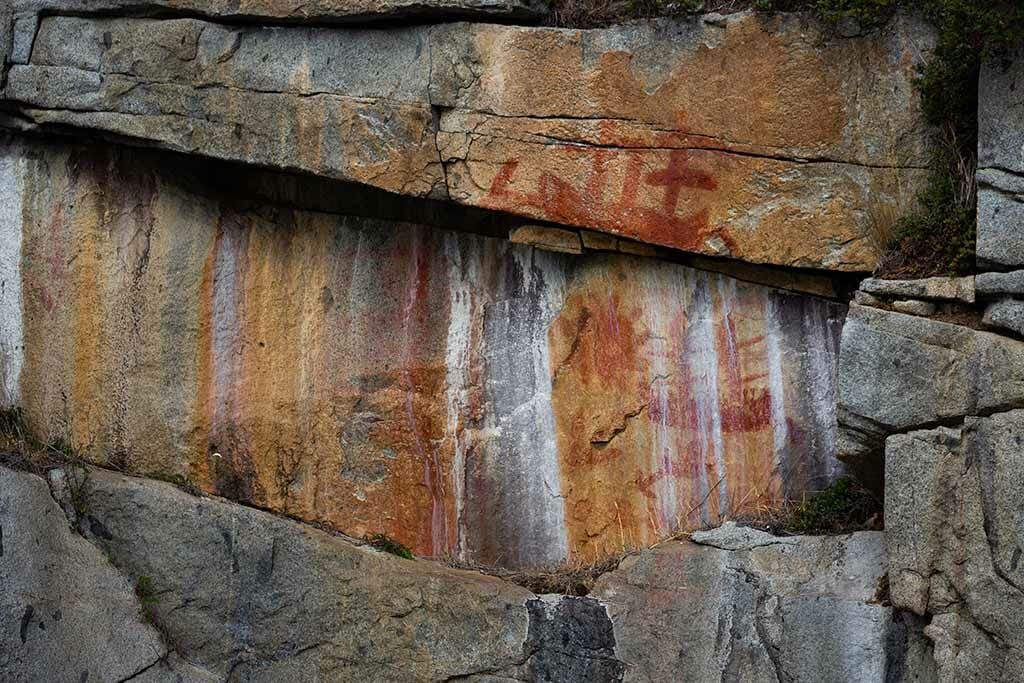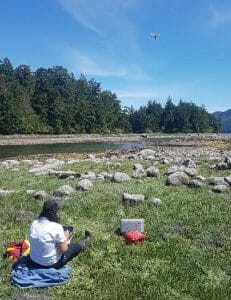Estimated Reading time

3 Mins
Tlowitsis Guardian Watchmen Map Sites of Cultural Importance


The territories of Tlowitsis First Nation span the coast of northern Vancouver Island, Johnstone Strait, and the adjacent mainland inlets. Until the 1960s, the Nation occupied sites throughout their lands and waters including their primary winter residence Kalagwees, located on Turnour Island.
The Tlowitsis were displaced from Kalagwees in the late 1960s. “This [led] our people to be culturally and physically separated from our traditional territories,” says the Tlowitsis website. Today, work being conducted by Tlowitsis Guardian Watchmen is helping to connect Tlowitsis members to their territories.
There are 370 recorded archeological sites within the territory of Tlowitsis First Nation. Each site provides an essential physical and spiritual link to the history, culture, and ancestors of the Nation. Between 2016 and 2019, the Tlowitsis Guardian Watchmen, led by Gina Thomas, visited 130 archeological sites to identify the location and assess the condition of each site.
“When we look at the evidence that is left behind by our ancestors, it gives us a better understanding of how they lived, and it also helps us fill in the missing pieces of the picture of how we got to where we are now,” says Thomas.
When we look at the evidence that is left behind by our ancestors, it gives us a better understanding of how they lived, and it also helps us fill in the missing pieces of the picture of how we got to where we are now.
The Guardians spent hundreds of hours across their territory surveying and mapping these archeological sites. Their work is essential; it deepens cultural understanding and ensures protection of these places from human and natural disturbances.
Tlowitsis First Nation recently published a report which highlights the incredible work Guardians have undertaken to locate, map, and assess archeological sites. Working side-by-side-by-side with Inlailawatash archaeologists on the report and data collection also allowed the Guardians to further develop their technical capacities.

The report reveals the importance of the Guardians’ work. The Guardians and Inlailawatash archaeologists discovered that most previously registered archaeological sites in Tlowitsis territory are only partially documented. Most sites within the territory are larger and have more features (for example, house depressions and shell middens, and fish traps) than was previously recorded. In fact, the team identified 29 new archeological sites including burial-box, village, and pictograph sites.
Both recorded and unrecorded archaeological sites were discovered to be highly vulnerable to natural-and human-caused disturbances. In some instances, damage to important sites was considerable. Ten archaeological sites were identified as possessing immediate vulnerability and/or cultural significance to the Tlowitsis Guardians.
Site protection and conservation are of critical importance to the Tlowitsis Guardians, as is an improved understanding of their heritage. One of the most significant and threatened sites identified by the Guardians is a Tlowitsis burial site. This site holds a burial box and ancestral remains within a rockshelter. Upon inspection of the site, the Guardians and Inlailawatash archaeologists discovered the rock wall covering the remains was disturbed and the box destroyed.
Doing what we can as Guardians to protect and document our past from natural and human impacts is important to us because our people have suffered many injustices since the time of contact.

“Doing what we can as Guardians to protect and document our past from natural and human impacts is important to us because our people have suffered many injustices since the time of contact,” Thomas is quoted in the report. “By working with non-Indigenous people that share our passions of the past can help bridge some of that ill will. I believe we can help each other gain knowledge that is more robust and encompassing by sharing our different views.”
The report also details research by Gina Thomas and her team that has opened new and exciting opportunities to expand knowledge of Tlowitsis’ past. Thomas has used drone photography and detailed site mapping of Bowers Island in Chatham Channel to discover dozens of stacked fish weirs, over 30 cleared canoe runs, shell midden, house depressions, and cultivated meadows of silverweed, chocolate lily, and other harvestable plants.
Learn more about the stewardship efforts and cultural well-being outcomes of work being undertaken by First Nations throughout the Great Bear Rainforest and Haida Gwaii.
In 2015, Coast Funds board of directors approved funding of $67,742 towards the start-up of the Tlowitsis Guardian Watchmen Program start-up. Since 2016, The Marine Plan Partnership a project of MakeWay Charitable Society has funded the Tlowitsis Guardian program to implement Cultural and Heritage objectives and strategies in the North Vancouver Island Marine Plan.
